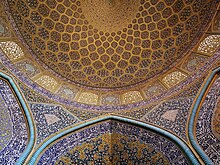
Back تصوير (إسلام) Arabic ইসলামে প্রতিকৃতিহীনতা Bengali/Bangla Bilderverbot im Islam German Pildikeeld islamis Estonian صورتگری در اسلام Persian Représentation figurée dans les arts de l'Islam French इस्लाम में अनीयनवाद Hindi Anikonisme dalam Islam ID Aniconismo nell'islam Italian Bildeforbudet i islam NB
This article includes a list of general references, but it lacks sufficient corresponding inline citations. (November 2011) |
| Part of a series on |
| Islam |
|---|
 |

In some forms of Islamic art, aniconism (the avoidance of images of sentient beings) stems in part from the prohibition of idolatry and in part from the belief that the creation of living forms is God's prerogative.
The Quran itself does not prohibit visual representation of any living being. The hadith collection of Sahih Bukhari explicitly prohibits the making of images of living beings, challenging painters who "breathe life" into their images and threatening them with punishment on the Day of Judgment.[1][2][a] Muslims have interpreted these prohibitions in different ways in different times and places. Religious Islamic art has been typically characterized by the absence of figures and extensive use of calligraphic, geometric and abstract floral patterns.
However, representations of Muhammad (in some cases, with his face concealed) and other religious figures are found in some manuscripts from lands to the east of Anatolia, such as Persia and India. Other forms of figurative arts existed since the formative stage of Islam.[4] These pictures were meant to illustrate the story and not to infringe on the Islamic prohibition of idolatry, but many Muslims regard such images as forbidden.[1] In secular art of the Muslim world, representations of human and animal forms historically flourished in nearly all Islamic cultures, although, partly because of opposing religious sentiments, figures in paintings were often stylized, giving rise to a variety of decorative figural designs. There were episodes of iconoclastic destruction of figurative art, such as the temporary decree by the Umayyad caliph Yazid II in 721 CE ordering the destruction of all representational images in his realm.[2][5] A number of historians have seen an Islamic influence on the Byzantine iconoclastic movement of the 8th century, though others regard this is as a legend that arose in later times in the Byzantine empire.[6]
- ^ a b Esposito, John L. (2011). What Everyone Needs to Know about Islam (2nd ed.). Oxford University Press. pp. 14–15.
- ^ a b "Figural Representation in Islamic Art". The Metropolitan Museum of Art.
- ^ Brend, Barbara. "Figurative Art in Medieval Islam and the Riddle of Bihzād of Herāt (1465–1535). By Michael Barry. p. 231-233. Paris, Flammarion, 2004." Journal of the Royal Asiatic Society 17.1 (2007): 231-233.
- ^ Brend, Barbara. "Figurative Art in Medieval Islam and the Riddle of Bihzād of Herāt (1465–1535). By Michael Barry. p. 49. Paris, Flammarion, 2004." Journal of the Royal Asiatic Society 17.1 (2007): 49
- ^ Wolfram Drews (2011). "Jewish or Islamic Influence? The Iconoclastic Controversy Dispute". Cultural Transfers in Dispute. Representations in Asia, Europe and the Arab World since the Middle Ages. Germany: Campus Verlag. p. 42.
- ^ Wolfram Drews (2011). "Jewish or Islamic Influence? The Iconoclastic Controversy Dispute". Cultural Transfers in Dispute. Representations in Asia, Europe and the Arab World since the Middle Ages. Germany: Campus Verlag. pp. 55–60.
Cite error: There are <ref group=lower-alpha> tags or {{efn}} templates on this page, but the references will not show without a {{reflist|group=lower-alpha}} template or {{notelist}} template (see the help page).